Prunella vulgaris, commonly known as self-heal, is charming little flower that never fails to make me smile.
The pretty purple blossoms seem to be calling to me from the ground saying, “Hello there! I know you’re busy, but take a quick moment to breathe and appreciate the beauty all around you!” ♥
But self-heal is so much more than just a pretty face. It possesses potent medicinal qualities, offering both topical and internal benefits, from wound healing to immune support.
A perennial member of the Lamiaceae family (also know as the mints), Prunella vulgaris is a low-growing perennial wildflower, typically growing to a height of about 2″ to 12″. Self-heal is known for its small, tubular, two-lipped purple flowers that bloom in dense spikes during the summer months. The flowers, which are easily self-heal’s most distinctive feature, grow in cylindrical clusters and can vary in color from pale purple to very dark violet, depending on the mineral content in the soil.
Self-heal stems range from green to purplish in color and are square-shaped, which is a characteristic feature of the mint family. The leaves of self-heal are opposite, meaning they grow in pairs along the stem, and are arranged in an alternating pattern. The long, lance-shaped leaves have a slightly hairy texture with toothed edges that vary from pronounced serrating to nearly smooth.
Self-heal has a small tap root and a fibrous rhizome root system. It can reproduce via seed and also asexually through a process called vegetative reproduction. It produces horizontal stems known as stolons or runners, which can root at various points wherever they touch the soil, forming new plantlets. The rooted plantlets then develop into individual self-heal plants, allowing self-heal to spread and colonize new areas rapidly.
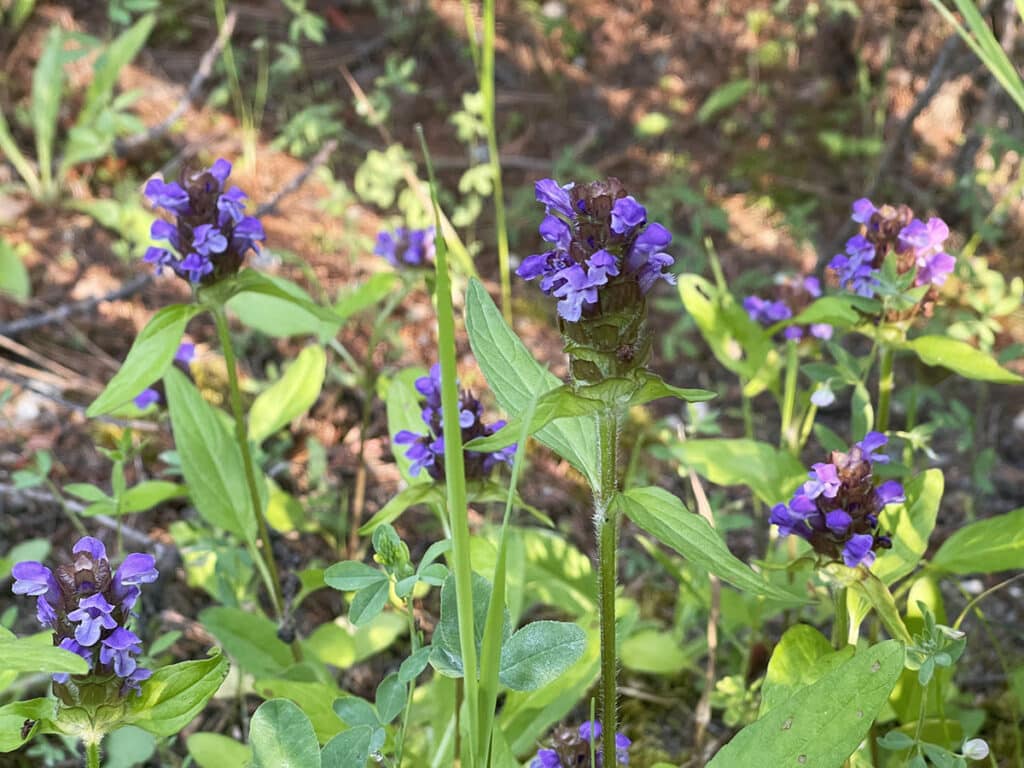
Self-heal is a native of Europe, but it can be found in other parts of the world, including Asia and North America —
and a happy little patch next to our mailbox that returns every year. ♥
Notable look-alikes
As always, it’s essential to be 110% certain of identification before you consume any plant for food or medicine. There are members of the mint family with similar appearances that, at certain points in their growth cycle, may be mistaken for Prunella vulgaris:
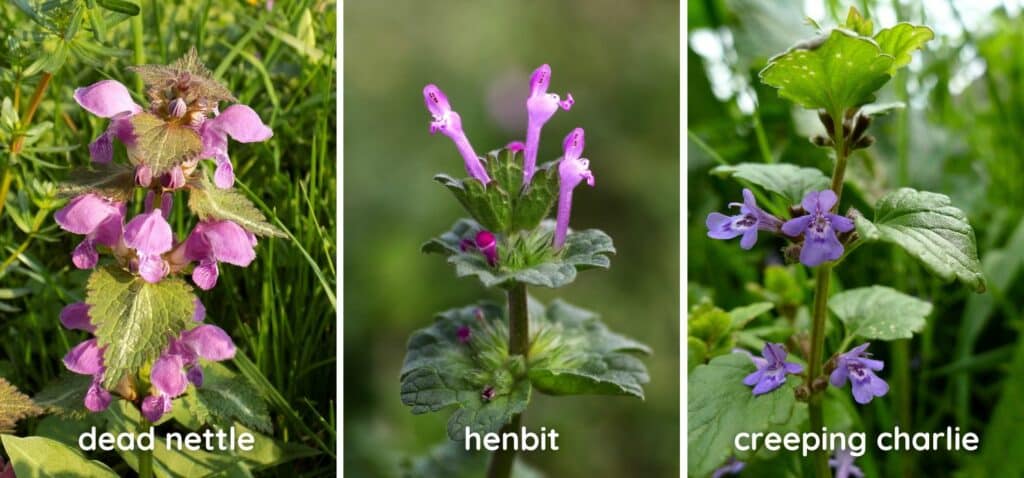
Purple dead-nettle (Lamium purpureum) flowers resemble those of self-heal with the characteristic mint-family ‘lip’ petals. Also typical of the Lamiaceae family, dead-nettles have square stems and opposite pairs of leaves. Unlike self-heal, though, dead-nettle’s leaves are fuzzy and rounded or heart-shaped with pronounced scalloped edges that resemble those of nettles (hence their name), while self-heal leaves tend to be sparsely hairy and elongated with smoother, more finely toothed margins.
Henbit (Lamium amplexicaule) is another potential self-heal doppelganger. Henbit’s leaves are rounded or heart-shaped with deeply toothed or scalloped edges, while self-heal leaves tend to have a more elongated shape with a serrated or slightly toothed margin. Unlike self-heal, henbit’s upper leaves are attached directly to the main stem and do not have a leaf petiole (stem). Henbit flowers are tubular-shaped and arranged in dense clusters at the top of the stems and can range from pink to purple. Self-heal flowers, on the other hand, are typically purple or violet-blue and have a distinct hooded appearance.
Creeping Charlie (Glechoma hederacea), also known as ground ivy, is another plant that might be mistaken for self-heal due to its purple flowers and opposite leaves on square stems. Creeping Charlie has round to kidney-shaped leaves with scalloped edges as opposed to self-heal’s longer, lanceolate leaves. Self-heal also has an upright growth habit, while creeping Charlie, (as its name suggests) has a trailing or creeping growth habit.
Dead nettle, henbit and creeping Charlie are all edible plants, but they will not have the same medicinal qualities of self-heal.
Self-heal as food
The young leaves of self-heal have a slightly bitter, herbaceous flavor and can be added fresh to salads or cooked as a leafy green vegetable. The flower heads make a fun, decorative garnish or addition to salads for a pop of color.
You can also make a self-heal infused honey. Raw, unfiltered honey is an interesting menstruum for its ability to extract water soluble constituents, as well as small amounts of oil soluble compounds, thanks to trace amounts of beeswax and pollen lipids. The honey will extract self-heal’s (water soluble) flavonoids and phenolic acids, as well as small amounts of its oil-soluble triterpenes and essential oils.
Incidentally, self-heal honey makes a wonderful addition to a medicine cabinet. Self-heal’s antimicrobial properties combined with the many healing properties of raw honey, make it an effective natural wound dressing. Try daubing some antiviral self-heal infused honey on a cold sore. Self-heal honey is also handy to have around when a sore throat strikes!
Of course, self-heal can also be used to make herbal teas. The dried or fresh leaves and flowers can be steeped in hot water to create a lovely, mild aromatic tea that can help to stimulate and support the immune system. Self-heal’s flavonoids and phenolic acids may help tone down inflammation, making it beneficial for sore throats or mouth ulcers. Self-heal tea is also used as a gentle digestive aid and may help to relieve symptoms of GI discomfort such as indigestion or bloating.
(Or sweeten your self-heal tea with a bit of your self-heal infused honey!)
When harvesting self-heal for culinary or medicinal purposes, always remember to ensure that the plant comes from a clean and pesticide-free environment. Never harvest from public roadsides that may have been sprayed.
When in doubt, find another source!
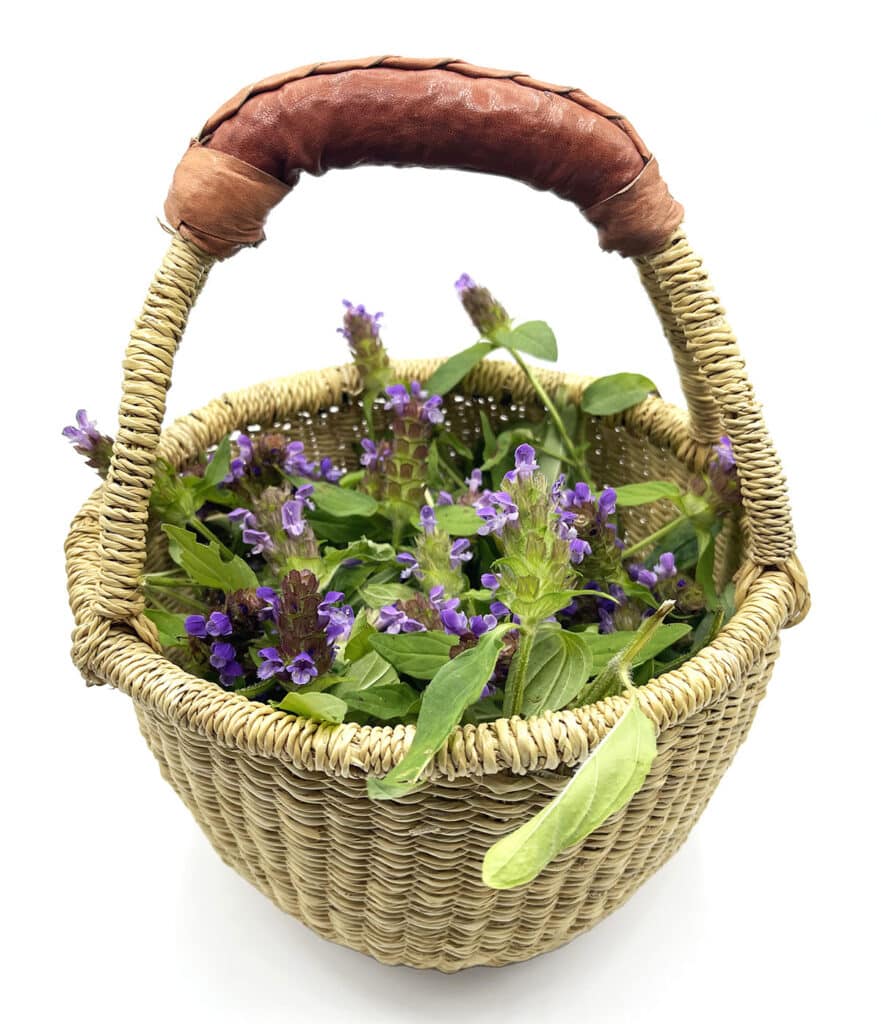
Self-heal as medicine
Self-heal has a long history of traditional use as a medicinal herb, used by various cultures around the world, including Chinese, European and Native American herbal medicine. It is mentioned in the Shen Nong Ben Cao Jing (The Divine Farmer’s Materia Medica), a Chinese herbal text compiled during the Han Dynasty (~200 BCE – 200 CE). The text describes self-heal as a useful plant for treating conditions such as fevers, sore throat and liver ailments.
Prunella vulgaris has shown antibacterial, antiviral and anti-fungal activities in laboratory studies. It is also believed to have immune-boosting effects and may help strengthen the body’s natural defenses.
It’s often used as an herbal remedy for sore throats, mouth ulcers and gum inflammation. Self-heal is also used to alleviate symptoms of common colds, respiratory infections and digestive issues.
Topically, the herb is believed to have wound-healing properties and can be applied as a poultice or salve to help soothe and heal minor cuts, burns and insect bites.
Self-heal contains a number of anti-inflammatory and antioxidant compounds that may modulate inflammation in the body and protect against oxidative stress.
It’s also been traditionally used as a diuretic to promote urine flow and as an herbal therapeutic for high blood pressure.
Self-heal contains various phytochemicals, including flavonoids, phenolic acids, tannins and triterpenes, that work synergistically to contribute to its therapeutic effects.
- Tannins in self-heal contribute to its astringent properties and can help reduce excessive secretions and tighten or tone tissues, making it beneficial for conditions like diarrhea, sore throat or minor wounds.
- Self-heal’s polysaccharides have immune-modulating effects and may support immune system function.
- Self-heal is rich in flavonoids, a class of compounds with antioxidant and anti-inflammatory properties. Flavonoids rutin, quercetin and kaempferol have been studied for their potential benefits in promoting cardiovascular health, reducing inflammation, and supporting immune function.
- Self-heal contains phenolic acids, including rosmarinic, caffeic and ferulic acids that contribute antioxidant, anti-inflammatory and antimicrobial properties. Rosmarinic acid, in particular, is known for its antioxidant, anti-inflammatory and antimicrobial effects and has been studied for its potential role in supporting immune function and reducing oxidative stress.
- Triterpenes are compounds found in self-heal that have been studied for their potential anti-inflammatory and antiviral effects. Ursolic acid and oleanolic acid are two triterpenes found in self-heal that have shown potential antimicrobial and anti-inflammatory activities. The triterpenes prunellin and prunellin A have been found to exhibit antiviral and antimicrobial activities.
- Self-heal produces essential oils that contain various volatile compounds, including menthol, thymol, and eugenol. These compounds contribute to the plant’s aromatic scent and may possess antimicrobial and soothing properties.
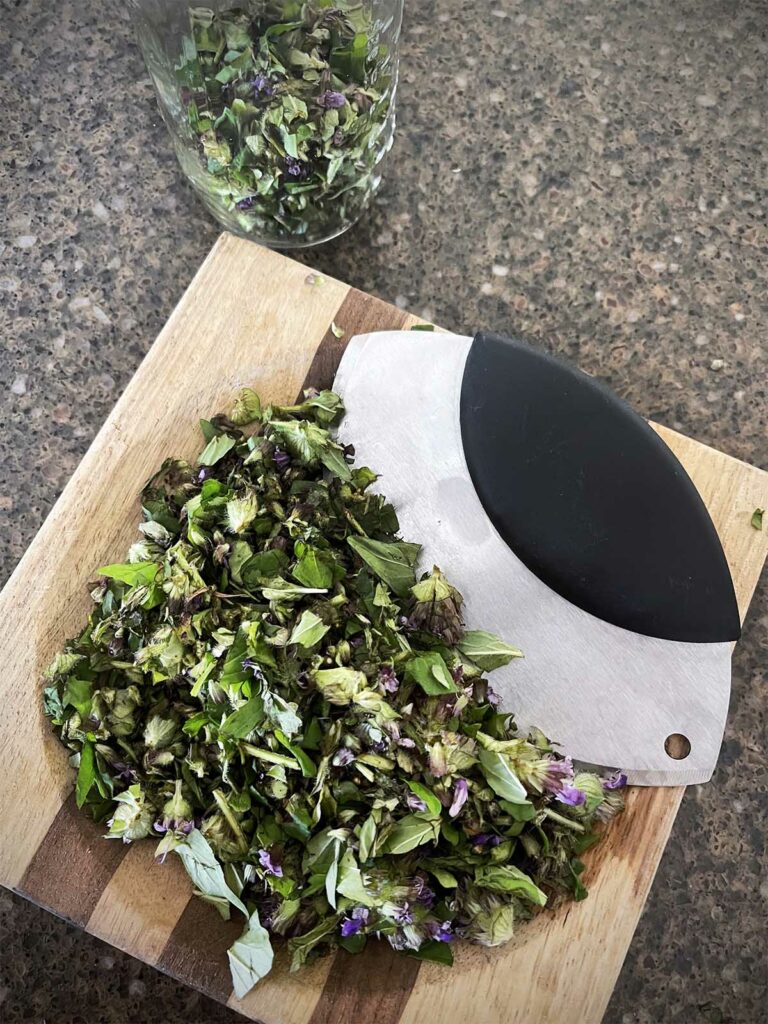
Harvesting time matters!
All plants have different needs at different stages in their reproductive cycles, and self-heal is no different. So it makes sense that you’re going to get variations in a plant’s active compounds (flavonoids, phenolic acids, triterpenes, essential oils, etc.) at different points in its life cycle.
Harvesting self-heal when it’s in full bloom, with vibrant and fully developed flowers, can result in a tincture that is richer in flavonoids and other secondary metabolites present in the flowers. Early growth stages also yield higher levels of certain essential oils, which the flower uses to attract pollinators.
Towards the end of the growing season, plants shift their focus toward storing energy and nutrients in their roots and rhizomes that will sustain them during the winter and support regrowth the following season.
Makes sense, right?
Since we’re mostly interested in self-heal’s aerial parts (stem, leaves and flowers) and not so much the roots, self-heal is best harvested when the flowers are in peak bloom — typically late spring or early summer, depending on your location. Look for plants with vibrant and fully developed flowers. Only pick plants that appear healthy and vigorous and avoid harvesting plants that are damaged, diseased or showing signs of stress.
Remember that sustainable harvesting practices should be always be followed to ensure the long-term viability of plant populations. Harvest only a portion of the available plants in a given area, allowing the rest to continue growing and reproducing.
The role of glycerin
For this preparation, I’m following Richo Cech’s guidelines for making a FRESH self-heal tincture using 65% alcohol, 25% water and 10% glycerin. If you don’t have access to fresh and are working with dried self-heal, aim for a lower alcohol content — 50% alcohol, 40% water and 10% glycerin is what Cech recommends.
What’s the 10% glycerin for?
Water and glycerin are both effective solvents for drawing out self-heal’s tannic acid. In an alcohol and water-based tincture like this one, glycerin serves another important purpose: It can stabilize the tannins, holding them in solution so they don’t settle to the bottom of the bottle.
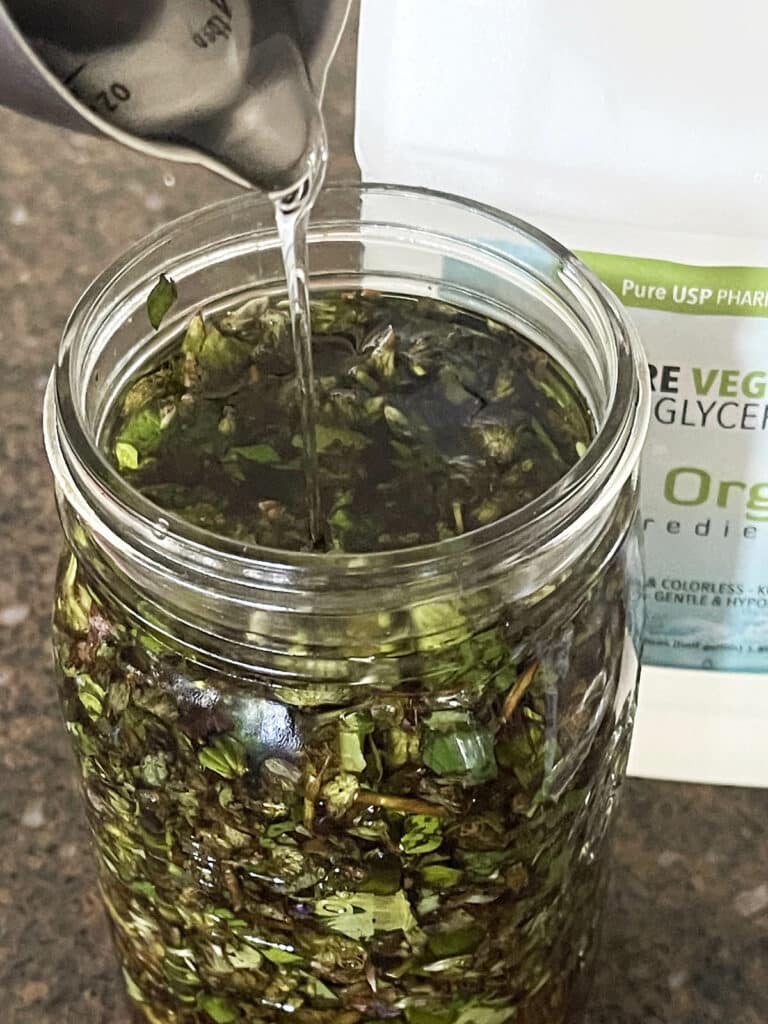
Using your tincture of self-heal
For a sore throat, Richo Cech recommends mixing one dropperful of self-heal tincture (about 30 drops) with 1/2 cup of water to create a gargle.
Self heal is specific for treating herpes lesions of the mucous membranes. Apply the tincture undiluted to an active cold sore to numb the pain and speed resolution of the sore. It’s recommended to also take internally as a tea, tincture or syrup/honey for a general tonic effect.
Cech recommends 30-60 drops of tincture diluted in water for adults taken as needed up to 5 times daily and 5 to 15 drops diluted in water for children, taken 3 to 5 times daily.
Self-heal is generally considered to be safe, but the American Herbal Products Association’s Botanical Safety Handbook cautions that self-heal may modify glucose regulation, so individuals with diabetes should monitor their blood glucose readings while taking self-heal.
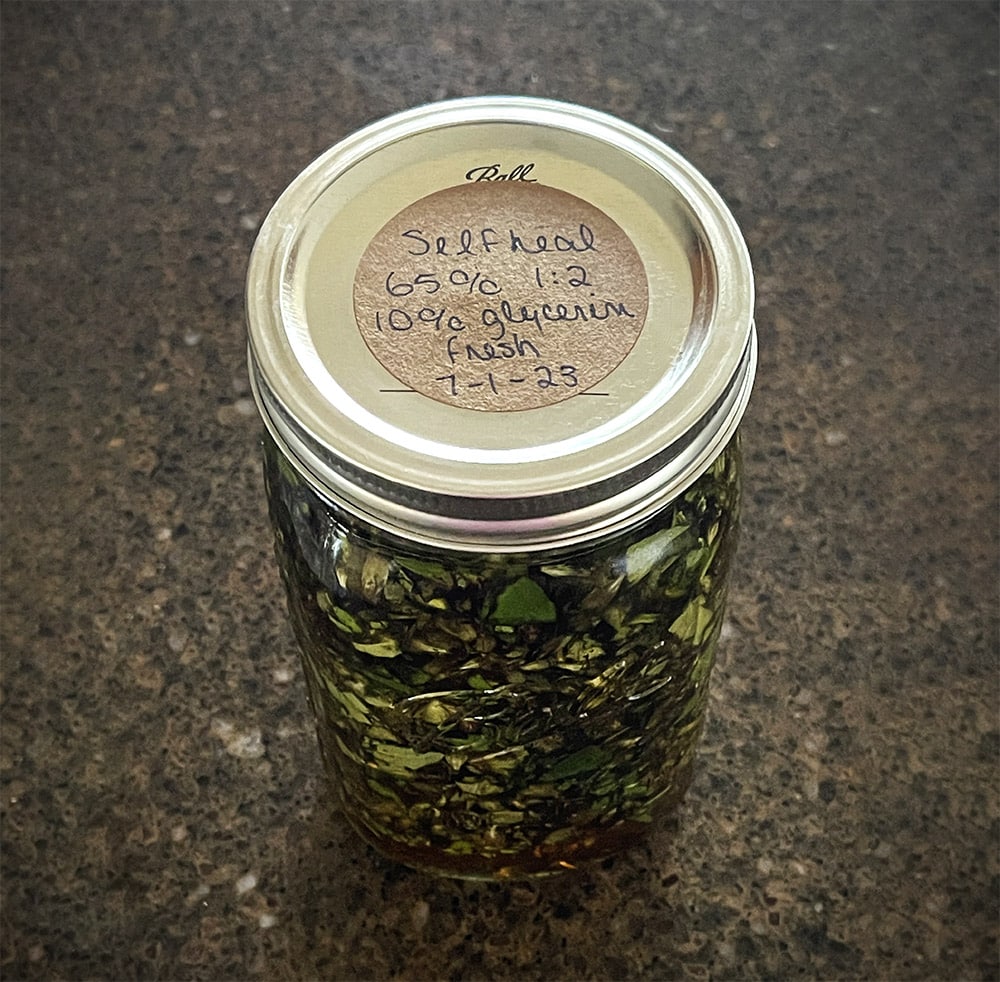
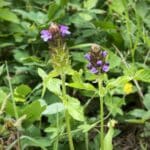
Fresh Self-Heal Tincture with Glycerin
5 Stars 4 Stars 3 Stars 2 Stars 1 Star
No reviews
Ingredients
Using 151-proof grain alcohol
12 fl oz neutral grain alcohol, 151 proof
1/2 fl oz distilled water
1 1/2 fl oz glycerin
Using 190-proof grain alcohol
9 1/2 fl oz neutral grain alcohol, 151 proof
3 fl oz distilled water
1 1/2 fl oz glycerin
Instructions
- Roughly chop self-heal flowers, leaves and stems.
- Fill a 1-pint mason jar to about the 3/4 mark with fresh self-heal. Pack it in, but not too tightly — you want the menstruum to be able to flow freely around the herb.
- Add neutral grain alcohol, distilled water and glycerin, stirring to combine. Add additional menstruum if needed to fully submerge the herb, keeping the alcohol : water : glycerin ratios consistent.
- Shake the jar daily, helping all of the plant matter to come in contact with the solvent.
- In 2 to 3 weeks, your tincture should be ready to strain and use. Use a fine mesh strainer lined with cheesecloth or a nut milk bag, squeezing the plant pulp to get every last drop. You may need to strain multiple times to remove all plant sediment from the tincture.
- Transfer to a clean glass bottle or jar with a tight-fitting lid — preferably an amber or dark colored bottle with UV protection. Store in dark place out of direct sunlight.
- Remember to label your tincture bottle with information such as the herb name (botanical and common), whether your tincture was made from fresh or dried herbs, the alcohol and glycerine percentages you used, plus the date. It’s also useful to include info about the tincture’s purpose and dosing recommendations so you don’t have to look it up each time you want to use your tincture.
Notes
Adult dosage: 30-60 drops diluted in water, 3-5 times daily (Richo Cech, Making Plant Medicine)
Children’s dosage: 5-15 drops diluted in water, 3-5 times daily (Richo Cech, Making Plant Medicine)

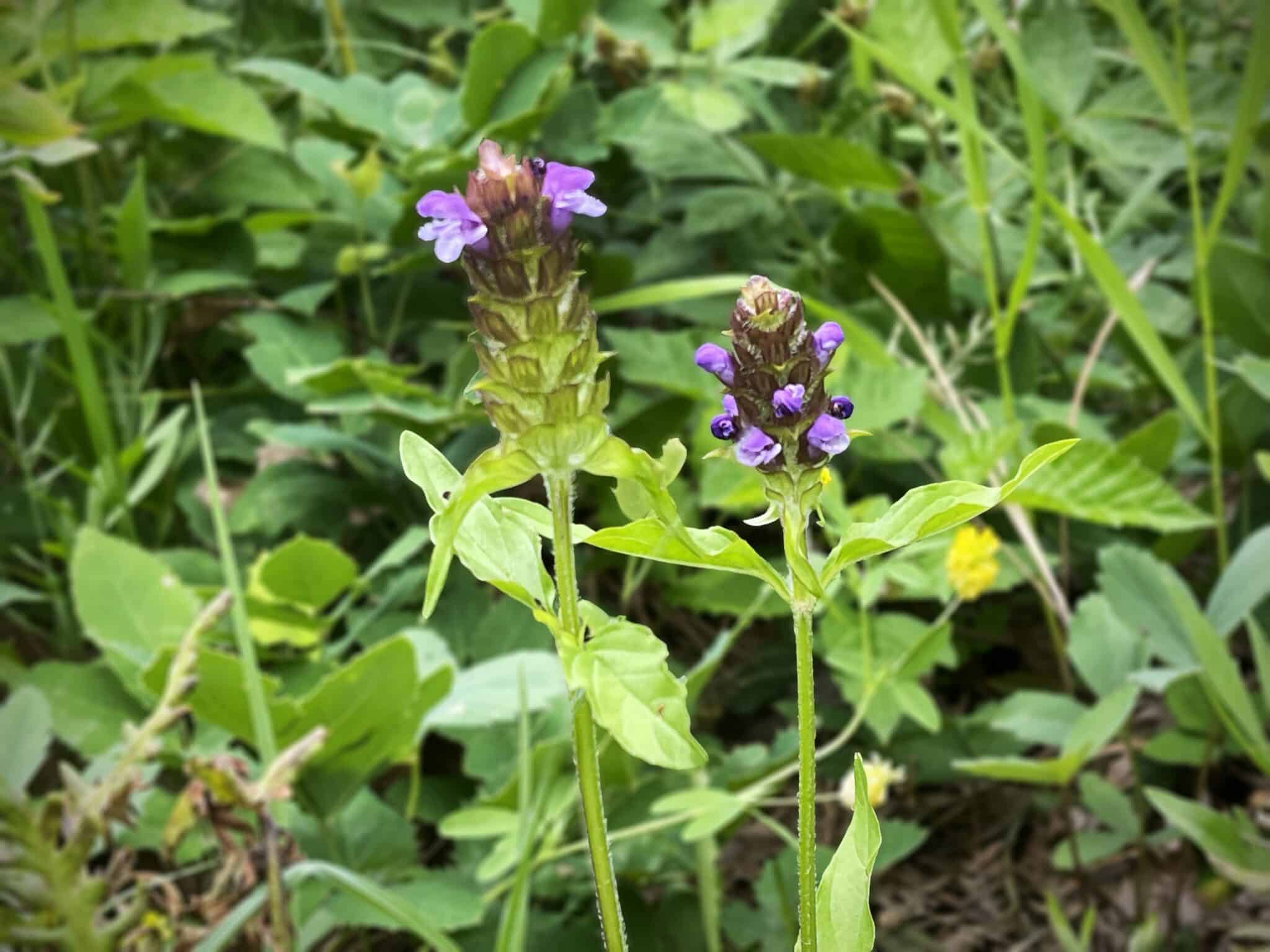


2 Responses
I made some of this over the summer but I didn’t realize I needed glycerin. Is my tincture ruined?
Not ruined at all — you’re still good! Glycerin isn’t required for a functional self-heal tincture. Its main job is to help keep the tannins suspended so they don’t precipitate out over time. Without it, you may notice a bit of sediment settling at the bottom of the bottle, but that doesn’t mean the tincture has gone bad or lost potency. Just give it a good shake before using, and you’re perfectly fine. If you want to add glycerin now, you can — but it’s absolutely not necessary for a safe and effective tincture ♥